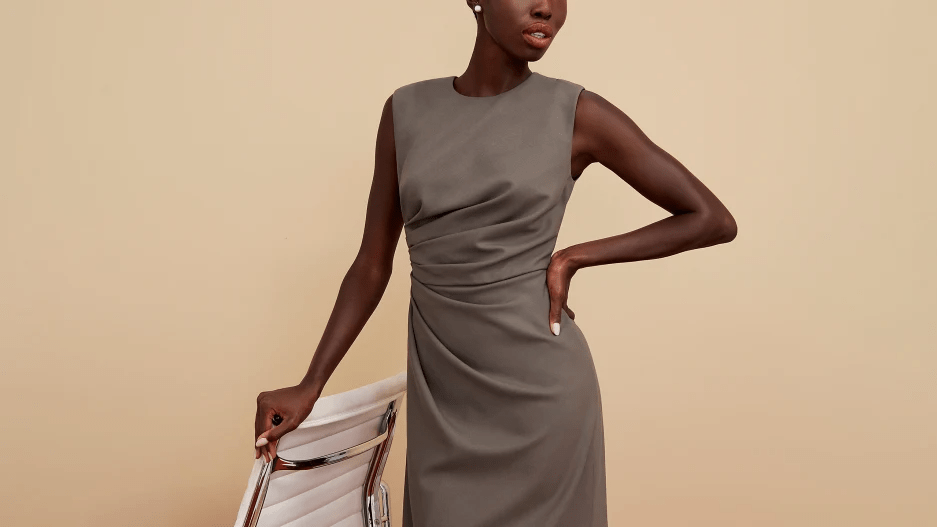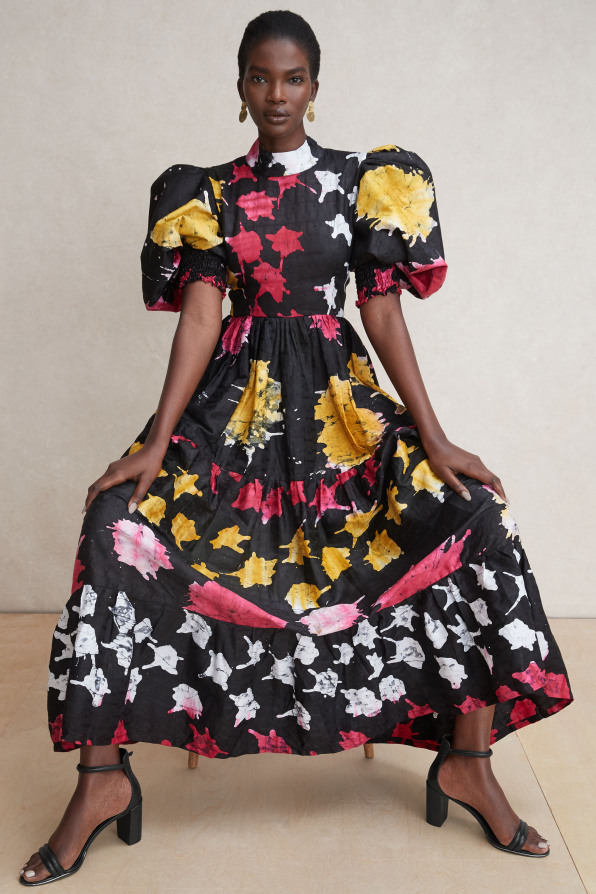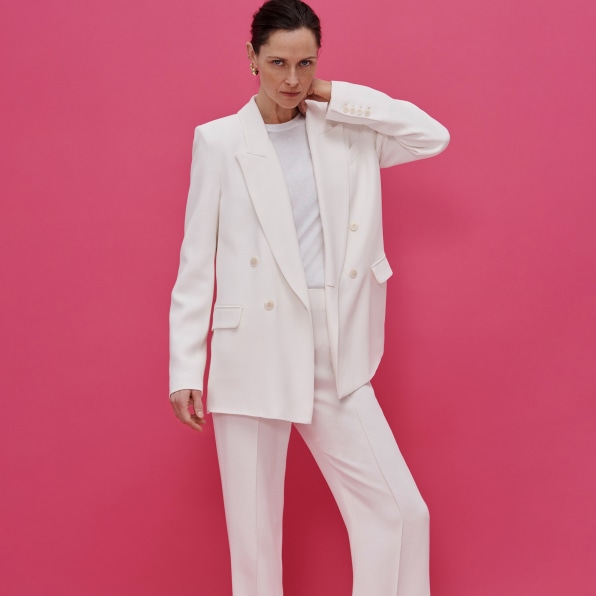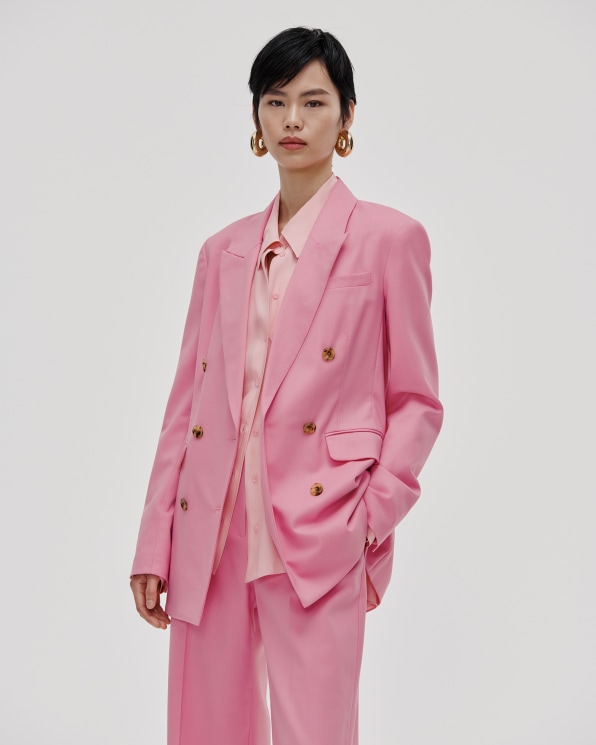- | 8:00 am
Power dressing for work is back. Here’s how to do it
Interviewing for your dream job? Pitching a big investor? Doing a TED talk? Three experts share their advice on how women can dress for big professional moments.

For a decade-and-a-half, Busayo Olupona worked as a corporate lawyer, wearing the industry’s uniform of prim suits or shift dresses every day. But one day, she decided she’d had enough of the rigid dress code that made all employees blend in; sometimes, she wanted to stand out. “If I showed up with some color and brightness, if I showed up with my personality, I felt like I could be more authentic,” she says.
On a trip to her native Nigeria, she found some traditional patterned fabric and asked a tailor to transform it into a simple A-line dress. When she wore it to the office, everyone wanted to know how they could get one of their own. Today, Olupona designs colorful Nigerian-inspired dresses for a living through her eponymous brand, Busayo. Women seek out her dresses and shirts when they’re trying to make an impression at work. “There’s some part of power dressing that is just about commanding attention,” she says. “Clothing is a quick and easy way to force people to see you.”

Sali Christeson, founder of Argent, a women’s suiting company worn by high-power women, including Alexandria Ocasio-Cortez and Kamala Harris, says that now, more than ever before, customers are coming in looking for outfits that will help them stand out. “Women bore the brunt of the pandemic,” Christeson says. “As they return to work, the dominant feeling is that they want to take back their power. They’re looking to use clothes to project power and confidence.”
More than 400 different research studies suggests that the pandemic set women back significantly more than men around the world. According to the Center for Global Development, more women lost their jobs, saw their earnings decrease, and faced career setbacks, compared to their male colleagues. This was partly because women shouldered much of the burden of caring for children and other family members. These struggles exacerbated existing gender inequity in the workplace.
It makes sense, then, that women are now trying to make up for some of these professional losses. Some are putting themselves back on the job market or interviewing for more senior positions. Others are trying to move up through the ranks in their existing job by taking more leadership roles or being more visible in presentations and important meetings. Founders might be looking to grow their businesses by pitching investors or speaking at events.
It’s clear that it will be a long, slow fight for women to regain their footing. Clothes are just one small part of the equation, but they can make women feel more confident as they put themselves out there again. That said, deciding to project power can be tricky. Christeson points out that you never want your clothes to be a distraction; instead, you want them to reinforce the message you are trying to communicate. She says there are three things to consider as you pick your power outfit: the specific audience, the industry you’re in, and your personal brand.

YOUR AUDIENCE
How much freedom you have with your wardrobe depends in part on the specific event you are dressing for. If you’re preparing for a job interview or a VC pitch, it’s crucial to be aware of how you might be perceived by those in the room. Christeson says you should do research about the company you’re meeting with to see what the typical dress code might be. “A lot of VCs are in Silicon Valley, where showing up in a full suit might make you look stuffy,” she says. “As much as I hate to say it, you need to look the part of the entrepreneur they would fund. Women are already so disadvantaged in these meetings, so you want your clothes to be an asset.”
If you’re already in a secure job and are trying to build your personal brand or project that you’re capable of more responsibility, you might be able to take more liberties with your power outfit. Here’s where you can wear the bold colors you love. For instance, Gretchen Whitmer wore Argent’s bright pink suit when she won reelection as governor of Michigan. This was a moment when she was no longer campaigning, but was in the mode of communicating the kind of progressive leader she would be.
You might also decide to skip traditional workwear altogether and wear something more unconventional. Some women pick Busayo dresses when they are giving a talk or speaking on a panel, given the pieces’ colorful palettes and striking silhouettes, like enormous puffed sleeves. Olupona says many women pick pieces from her collection that are variations on more traditional shift dresses, with pops of color or exaggerated proportions. The key, she says, is to make sure you feel comfortable in what you’re wearing. “I think there’s something inherently powerful about showing a little bit of who we are through what we’re wearing,” Olupona says. “It allows us to feel more at ease and in control.”

THE INDUSTRY
While professional dress codes are loosening across the entire economy, there are still many sectors that are more conservative, including law, politics, and consulting.
Sarah LaFleur, founder of the professional clothing brand M.M.LaFleur, knows these industries intimately, as her business is devoted to helping women in these careers dress for work. She says that power dressing in these contexts is about subtle tweaks. “If the norm is to wear a suit, you can push the boundaries by wearing more color or wearing slightly exaggerated silhouettes,” she says.
One way to take things up a notch is to wear an oversize blazer, which is a new workwear staple. And LaFleur says that even in the most buttoned up industries, you can add a little twist of color by veering off the neutrals and picking shades of blue or olive. Another way to add visual interest is to play with texture. Rather than going for a traditional wool or crepe suit, you might go for a bouclé blazer. For instance, the brand has a thigh-length textured jacket with a fringe that has been popular with customers trying to make a statement, but not wanting to go too far. “These are small cues that will ensure that you’re memorable, but make it clear you are fully aware of your context,” LaFleur says.

YOUR PERSONAL BRAND
Garments, if deployed well, can communicate a lot. They can reveal to your audience that you are ambitious, capable of commanding a room, and ready to lead. They can also reveal aspects of your personality, like whether you gravitate toward louder, more dramatic silhouettes, or more muted, classic ones.
While some people are comfortable using clothing to tell a story about who they are, this comes harder to others, who may not be comfortable with navigating fashion. Indeed, LaFleur started M.M.LaFleur for women who don’t love shopping, or don’t have time to invest in thinking about how they show up at work. “In some ways, the more fluid dress codes at work can be harder for women who are busy and find it stressful to get dressed in the morning,” she says.
Christeson says its worth spending some time trying on different outfits to see what feels most comfortable. Then, she suggests just getting a capsule wardrobe that you can wear on repeat, putting different pieces together for different occasions. You might get an oversized suit that you wear for big presentations, but wear the blazer and trousers separately at other times, when you want a more subtle look. And, it’s always good to experiment with colors and styles, she says. She’s found that customers sometimes fall in love with pieces they didn’t think they would like. “They come in expecting to buy neutrals and walk out with a cobalt-blue suit,” she says. “Then a few months later, they come back asking for the same suit in bubblegum pink.”








































